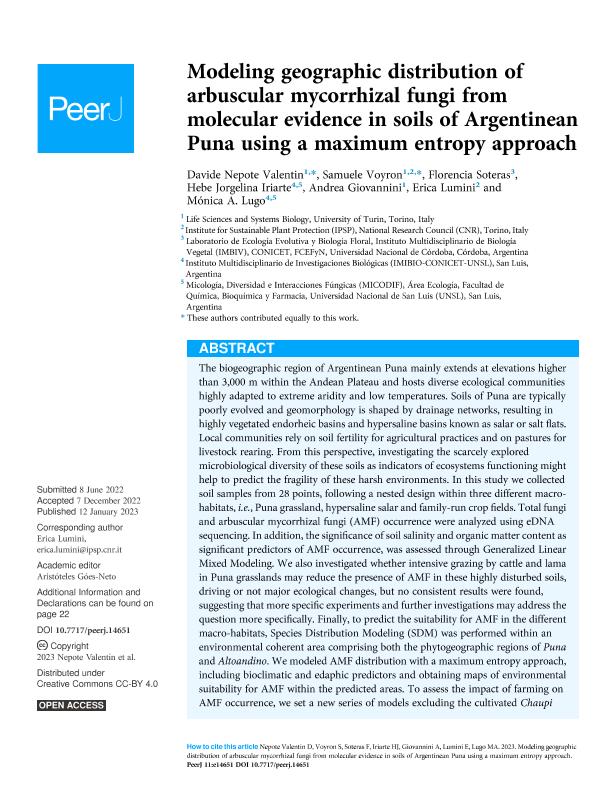Artículo
Modeling geographic distribution of arbuscular mycorrhizal fungi from molecular evidence in soils of Argentinean Puna using a maximum entropy approach
Nepote Valentin, Davide; Voyron, Samuele; Soteras, María Florencia ; Iriarte, Hebe Jorgelina
; Iriarte, Hebe Jorgelina ; Giovannini, Andrea; Lumini, Erica; Lugo, Mónica Alejandra
; Giovannini, Andrea; Lumini, Erica; Lugo, Mónica Alejandra
 ; Iriarte, Hebe Jorgelina
; Iriarte, Hebe Jorgelina ; Giovannini, Andrea; Lumini, Erica; Lugo, Mónica Alejandra
; Giovannini, Andrea; Lumini, Erica; Lugo, Mónica Alejandra
Fecha de publicación:
12/01/2023
Editorial:
PeerJ, Inc.
Revista:
PeerJ
ISSN:
2167-8359
Idioma:
Inglés
Tipo de recurso:
Artículo publicado
Clasificación temática:
Resumen
The biogeographic region of Argentinean Puna mainly extends at elevations higher than 3,000 m within the Andean Plateau and hosts diverse ecological communities highly adapted to extreme aridity and low temperatures. Soils of Puna are typically poorly evolved and geomorphology is shaped by drainage networks, resulting in highly vegetated endorheic basins and hypersaline basins known as salar or salt flats. Local communities rely on soil fertility for agricultural practices and on pastures for livestock rearing. From this perspective, investigating the scarcely explored microbiological diversity of these soils as indicators of ecosystems functioning might help to predict the fragility of these harsh environments. In this study we collected soil samples from 28 points, following a nested design within three different macro-habitats, i.e., Puna grassland, hypersaline salar and family-run crop fields. Total fungi and arbuscular mycorrhizal fungi (AMF) occurrence were analyzed using eDNA sequencing. In addition, the significance of soil salinity and organic matter content as significant predictors of AMF occurrence, was assessed through Generalized Linear Mixed Modeling. We also investigated whether intensive grazing by cattle and lama in Puna grasslands may reduce the presence of AMF in these highly disturbed soils, driving or not major ecological changes, but no consistent results were found, suggesting that more specific experiments and further investigations may address the question more specifically. Finally, to predict the suitability for AMF in the different macro-habitats, Species Distribution Modeling (SDM) was performed within an environmental coherent area comprising both the phytogeographic regions of Puna and Altoandino. We modeled AMF distribution with a maximum entropy approach, including bioclimatic and edaphic predictors and obtaining maps of environmental suitability for AMF within the predicted areas. To assess the impact of farming on AMF occurrence, we set a new series of models excluding the cultivated Chaupi Rodeo samples. Overall, SDM predicted a lower suitability for AMF in hypersaline salar areas, while grassland habitats and a wider temperature seasonality range appear to be factors significantly related to AMF enrichment, suggesting a main role of seasonal dynamics in shaping AMF communities. The highest abundance of AMF was observed in Vicia faba crop fields, while potato fields yielded a very low AMF occurrence. The models excluding the cultivated Chaupi Rodeo samples highlighted that if these cultivated areas had theoretically remained unmanaged habitats of Puna and Altoandino, then large-scale soil features and local bioclimatic constraints would likely support a lower suitability for AMF. Using SDM we evidenced the influence of bioclimatic, edaphic and anthropic predictors in shaping AMF occurrence and highlighted the relevance of considering human activities to accurately predict AMF distribution.
Archivos asociados
Licencia
Identificadores
Colecciones
Articulos(IMBIV)
Articulos de INST.MULTIDISCIPL.DE BIOLOGIA VEGETAL (P)
Articulos de INST.MULTIDISCIPL.DE BIOLOGIA VEGETAL (P)
Citación
Nepote Valentin, Davide; Voyron, Samuele; Soteras, María Florencia; Iriarte, Hebe Jorgelina; Giovannini, Andrea; et al.; Modeling geographic distribution of arbuscular mycorrhizal fungi from molecular evidence in soils of Argentinean Puna using a maximum entropy approach; PeerJ, Inc.; PeerJ; 11; 12-1-2023; 1-30
Compartir



